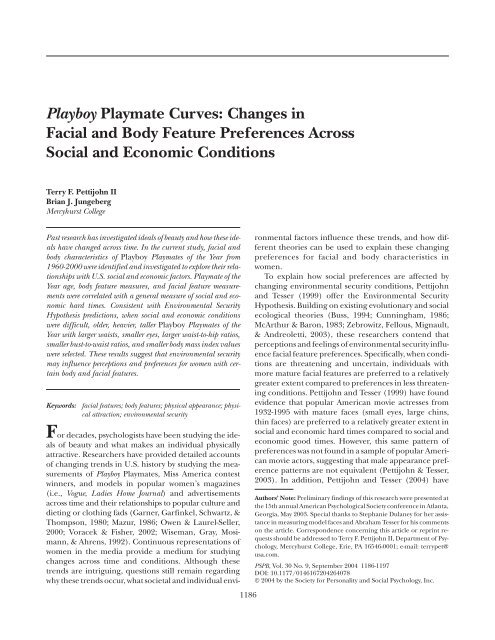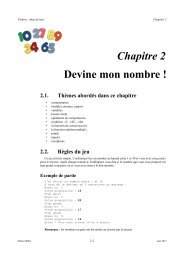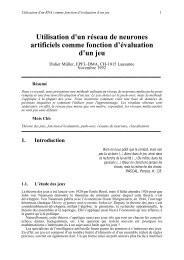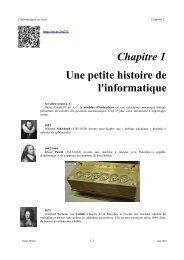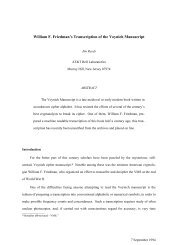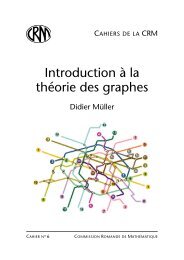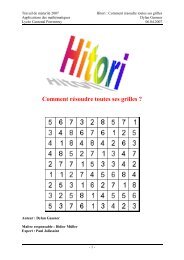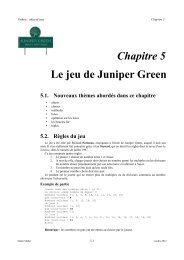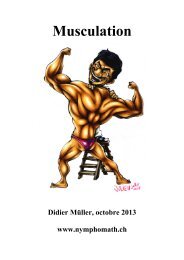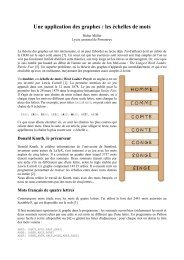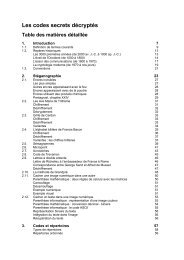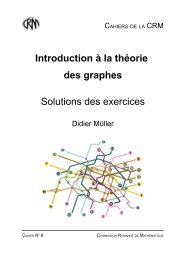Playboy Playmate Curves: Changes in Facial and ... - Feminine beauty
Playboy Playmate Curves: Changes in Facial and ... - Feminine beauty
Playboy Playmate Curves: Changes in Facial and ... - Feminine beauty
You also want an ePaper? Increase the reach of your titles
YUMPU automatically turns print PDFs into web optimized ePapers that Google loves.
Pettijohn, Jungeberg / PLAYBOY PLAYMATE CURVES 1193In addition, the GHTM was lagged for 1 <strong>and</strong> 2 years<strong>and</strong> the relationship between these delayed statistics <strong>and</strong><strong>Playmate</strong> of the Year features was assessed. Results werenot stronger than the orig<strong>in</strong>al outcomes <strong>in</strong> either case.DISCUSSIONConsistent with the Environmental Security Hypothesispredictions, when social <strong>and</strong> economic conditionswere difficult, older, heavier, taller <strong>Playboy</strong> <strong>Playmate</strong>s ofthe Year with larger waists, smaller eyes, larger waist-tohipratios, smaller bust-to-waist ratios, <strong>and</strong> smaller bodymass <strong>in</strong>dex values were selected. Conversely, as <strong>in</strong>dicatedwith the prescribed correlations, as social <strong>and</strong> economicconditions improved, younger, lighter, shorter <strong>Playboy</strong><strong>Playmate</strong>s of the Year with smaller waists, larger eyes,smaller waist-to-hip ratios, larger bust-to-waist ratios, <strong>and</strong>larger body mass <strong>in</strong>dex values were preferred. Maturefeatures <strong>and</strong> a more tubular body shape were preferredto a relatively greater extent when times were bad <strong>and</strong>neotenous features <strong>and</strong> a more curvaceousness bodytype were preferred when times were good.Although there was overall support for the EnvironmentalSecurity Hypothesis predictions, <strong>Playmate</strong> of theYear ch<strong>in</strong> size <strong>and</strong> facial th<strong>in</strong>ness did not follow the predictedpattern of relat<strong>in</strong>g positively with hard social <strong>and</strong>economic conditions. The measures of facial th<strong>in</strong>ness,ch<strong>in</strong> length, ch<strong>in</strong> width, <strong>and</strong> ch<strong>in</strong> area showed no relationshipwith the General Hard Times Measure, whereasthe eye measures were significantly negatively related tosocial <strong>and</strong> economic hard times. One way to expla<strong>in</strong> thisdiscrepancy may lie <strong>in</strong> the weighted importance of bodyfeatures over facial features for this particular sample.Nude models are selected for their <strong>beauty</strong>, but the significanceof physical attractiveness may be connected morewith body features than facial features for <strong>Playboy</strong> centerfolds.Hav<strong>in</strong>g a strong ch<strong>in</strong> or a th<strong>in</strong> face may be ofsmaller consequence for <strong>Playmate</strong>s, whereas body features,such as height <strong>and</strong> fat distribution, may be oflarger consequence <strong>in</strong> determ<strong>in</strong><strong>in</strong>g attractiveness. Incontrast, movie actresses may rely more on facial appearancethan body appearance for their profession, hencethe connection of eye size, ch<strong>in</strong> size, <strong>and</strong> facial th<strong>in</strong>nesswith social <strong>and</strong> economic conditions <strong>in</strong> the actress sample(Pettijohn & Tesser, 1999). In addition, researchf<strong>in</strong>d<strong>in</strong>gs concern<strong>in</strong>g eye size differences <strong>and</strong> attributionshave yielded robust f<strong>in</strong>d<strong>in</strong>gs <strong>in</strong> the arena of facialfeature <strong>in</strong>vestigations, whereas other facial features havebeen more variable (see Zebrowitz, 1997).Although relationships between feature measurements<strong>and</strong> the state of the social <strong>and</strong> economic environmentwere exposed, the range of facial <strong>and</strong> body measurementvalues was somewhat restricted. For example,the statement that taller <strong>and</strong> older <strong>Playmate</strong>s of the Yearwere selected <strong>in</strong> social <strong>and</strong> economic bad times must betaken <strong>in</strong> context. The tallest <strong>Playmate</strong> <strong>in</strong> the sample was71 <strong>in</strong>. tall, the shortest was 62 <strong>in</strong>., <strong>and</strong> the oldest <strong>Playmate</strong><strong>in</strong> the sample was 33 years old, the youngest was 18. Certa<strong>in</strong>ly,these values do not represent extremes. Furthermore,accord<strong>in</strong>g to the National Center for Chronic DiseasePrevention <strong>and</strong> Health Promotion (www.cdc.gov/nccdphp/dnpa/bmi), when consider<strong>in</strong>g body mass<strong>in</strong>dex (BMI), 19 of the 41 <strong>Playmate</strong>s of the Year would beclassified as underweight (below 18.5) <strong>and</strong> the rema<strong>in</strong><strong>in</strong>g22 would be classified as average (18.5-24.9). Nonefell <strong>in</strong>to the overweight or obese categories <strong>and</strong> the averageBMI of all <strong>Playmate</strong>s of the Year was slightly above them<strong>in</strong>imum to be placed <strong>in</strong>to the normal category. Therefore,these results may only be generalized to nonobesefemale populations (see S<strong>in</strong>gh, 1993).Of <strong>in</strong>terest, recent research has found that underweightfemale figures were rated as more attractive thannormal weight or overweight figures, <strong>and</strong> figures with ahigh waist-to-hip ratio (.86) were considered moreattractive than the figures with a low waist-to-hip ratioacross all weight conditions (Puhl & Bol<strong>and</strong>, 2001).These f<strong>in</strong>d<strong>in</strong>gs run counter to S<strong>in</strong>gh’s (1993) orig<strong>in</strong>alresults <strong>and</strong> a follow-up (S<strong>in</strong>gh & Young, 1995) show<strong>in</strong>gthat larger body size, waist-to-hip ratio, <strong>and</strong> hips alsomade women appear older <strong>and</strong> less desirable. Tass<strong>in</strong>ary<strong>and</strong> Hansen (1998) also show that waist size, hip size, <strong>and</strong>weight can be varied to produce differences <strong>in</strong> waist-tohipratio judgments of attractiveness. These recent f<strong>in</strong>d<strong>in</strong>gssuggest that preferences may have strongersociocultural <strong>in</strong>fluences that depend less on evolution<strong>and</strong> that these ideals may change. Perhaps the samples,which were tested at different times <strong>and</strong> <strong>in</strong> different locations,experienced differences <strong>in</strong> environmental securitythat could partially expla<strong>in</strong> this discrepancy. With<strong>in</strong>an average range of body shapes <strong>and</strong> weights, largerwaist-to-hip ratios may be preferred to a relatively greaterextent when environmental security is high compared touncerta<strong>in</strong> conditions. This possibility warrants future<strong>in</strong>vestigation.Although correlational <strong>in</strong> nature, these results suggestthat environmental security may <strong>in</strong>fluence perceptions<strong>and</strong> preferences for <strong>Playmate</strong>s with certa<strong>in</strong> body<strong>and</strong> facial features. We recognize the limitations of us<strong>in</strong>gthe <strong>Playboy</strong> <strong>Playmate</strong> of the Year competition as a sourceof preferences for female attractiveness over time. <strong>Playboy</strong>is <strong>in</strong> bus<strong>in</strong>ess to sell magaz<strong>in</strong>es. They would not beable to sell magaz<strong>in</strong>es if they featured unattractivewomen who were not desirable to their subscribers.Therefore, it is <strong>in</strong> the company’s best <strong>in</strong>terest to knowwhat the public wants <strong>in</strong> order to be successful. Somehave speculated that model photos are airbrushed <strong>and</strong>“corrected” <strong>in</strong> edit<strong>in</strong>g. To the extent that any alterationsare made, we would argue that they would be <strong>in</strong> thedirection of the current societal trends. Furthermore, if
1194 PERSONALITY AND SOCIAL PSYCHOLOGY BULLETINimages are always corrected <strong>in</strong> the same fashion, thispractice could not account for the current pattern ofchang<strong>in</strong>g preferences with social <strong>and</strong> economic conditions.Does <strong>Playboy</strong> mirror American culture? We believeso, <strong>and</strong> the editors of <strong>Playboy</strong> magaz<strong>in</strong>e certa<strong>in</strong>ly th<strong>in</strong>k so.Accord<strong>in</strong>g to Hugh Hefner, “No other magaz<strong>in</strong>e <strong>and</strong> noother images more dramatically reflect the culturalchanges that America has been through dur<strong>in</strong>g the lasthalf of the 20th century” (The <strong>Playmate</strong> Book, 1996, p. 13).We also recognize the limitations of us<strong>in</strong>g the GHTMas an <strong>in</strong>dicator of social <strong>and</strong> economic conditions <strong>in</strong>America over time. The GHTM is a gross, societal <strong>in</strong>dicatorthat is not sensitive to all social <strong>and</strong> economic threat.As noted earlier, events such as assass<strong>in</strong>ations of importantpolitical <strong>and</strong> social leaders <strong>and</strong> acts of violence <strong>in</strong>the United States, such as September 11, 2001, may notbe captured <strong>in</strong> the current measure. The GHTM alsodoes not allow for a precise assessment of how particulargroups (i.e., men) or <strong>in</strong>dividuals themselves are <strong>in</strong>fluencedby the social <strong>and</strong> economic conditions. Futureexperimental work may correct these limitations. However,the GHTM <strong>in</strong>cludes many of the components cited<strong>in</strong> previous archival research on societal threat (i.e.,Doty, Peterson, & W<strong>in</strong>ter, 1991; McCann, 1991; Sales,1972, 1973), such as unemployment, consumer price<strong>in</strong>dex, suicide, homicide, <strong>and</strong> divorce, <strong>and</strong> provides anice consistency of methodology <strong>in</strong> which to make comparisonsto American actresses (Pettijohn & Tesser,1999). In other archival <strong>in</strong>vestigations, societal measuresof threat <strong>in</strong> America have been related to powerful <strong>and</strong>charismatic presidential c<strong>and</strong>idate preferences (McCann,1991, 1997; McCann & Stew<strong>in</strong>, 1987), authoritarianchurch affiliation, attack dog preference, strong literarycharacter personality, prevalence of violent sport<strong>in</strong>gevents (Doty et al., 1991; Sales, 1972, 1973), mature facialfeature preferences <strong>in</strong> popular American actresses(Pettijohn & Tesser, 1999), <strong>and</strong> even television view<strong>in</strong>gpreferences for mean<strong>in</strong>gful content (McIntosh,Schwegler, & Terry-Murray, 2000). These outcomes are<strong>in</strong> l<strong>in</strong>e with the current f<strong>in</strong>d<strong>in</strong>gs <strong>in</strong>volv<strong>in</strong>g <strong>Playboy</strong> <strong>Playmate</strong>sof the Year. Our likes <strong>and</strong> dislikes are <strong>in</strong>deed <strong>in</strong>fluencedby environmental conditions <strong>and</strong> perceptions ofthreat.Culture also may <strong>in</strong>fluence preferences for attraction<strong>in</strong> female facial <strong>and</strong> body features. Anderson et al.(1992) suggest that attitudes toward female fatnessacross cultures are <strong>in</strong>fluenced by availability of food, climate,social dom<strong>in</strong>ance of women, <strong>and</strong> women’s value <strong>in</strong>the workplace. The current study <strong>in</strong>vestigated Americanpreferences, <strong>and</strong> cross-cultural replications would certa<strong>in</strong>lystrengthen our f<strong>in</strong>d<strong>in</strong>gs. In addition, it should benoted that the <strong>Playmate</strong>s of the Year were predom<strong>in</strong>atelyof Anglo-American <strong>and</strong> of European decent. Althoughmonthly <strong>Playmate</strong>s from many cultural <strong>and</strong> racial backgroundshave been featured <strong>in</strong> <strong>Playboy</strong>, only one<strong>Playmate</strong> of the Year has been African American (1990:Rene Tenison). Consider<strong>in</strong>g the lack of diversity <strong>in</strong> the<strong>Playmate</strong> of the Year, it is important to consider theimplications for preferences between <strong>and</strong> with<strong>in</strong> differentraces. For example, research has shown that U.S.African American men prefer larger African Americanfemale body types compared to Anglo-American men’spreferences for smaller Anglo-American female bodytypes (Jackson & McGill, 1996; Rosenfeld, Stewart,St<strong>in</strong>nett, & Jackson, 1999). This research suggests a racespecificprototype of body attractiveness to help expla<strong>in</strong>cultural differences <strong>and</strong> regional variations with<strong>in</strong> cultures.If a particular race is exposed to a greater social<strong>and</strong> economic threat than another race, this threat may<strong>in</strong>fluence preferences <strong>in</strong> the manner suggested <strong>in</strong> thecurrent Environmental Security Hypothesis.Although relationships were reported <strong>in</strong> the currentstudy, we do not account for all of the variance <strong>in</strong> selections<strong>and</strong> recognize that other factors certa<strong>in</strong>ly <strong>in</strong>fluencepreferences for <strong>Playboy</strong> <strong>Playmate</strong> of the Year. Besidesthose mentioned previously, model leg length, haircolor, <strong>and</strong> the presence of a tan (Broadstock, Borl<strong>and</strong>, &Gason, 1992) may <strong>in</strong>fluence perceived attractiveness aswell. As noted <strong>in</strong> the commentaries to Voracek <strong>and</strong>Fisher’s (2002) study on temporal changes of <strong>Playmate</strong>body measures, geographical <strong>and</strong> historical variation <strong>in</strong>body size are important considerations (McQueen,2003) <strong>and</strong> the media is not the only <strong>in</strong>fluence on bodyimage changes (Boynton, 2003). Complex social factors,evolutionary forces, <strong>and</strong> learn<strong>in</strong>g are central to determ<strong>in</strong><strong>in</strong>gbody shape <strong>and</strong> size preferences.The results of the current <strong>in</strong>vestigation provide additionalsupport for the Environmental Security Hypothesis<strong>and</strong> extend support from facial feature preferences to<strong>in</strong>clude body feature preferences. These f<strong>in</strong>d<strong>in</strong>gs are<strong>in</strong>trigu<strong>in</strong>g <strong>and</strong> suggest our preferences are shaped byour environmental perceptions of security. Additionalwork consider<strong>in</strong>g how personality preferences are <strong>in</strong>fluencedby environmental security may be useful. Alternativereplications <strong>in</strong> various cultures or us<strong>in</strong>g differentsamples, such as models, <strong>beauty</strong> contestants, or otherhighly visible representations of societal preferences ofattraction, would <strong>in</strong>crease reliability of these f<strong>in</strong>d<strong>in</strong>gs.But perhaps the most essential l<strong>in</strong>e of future research<strong>in</strong>cludes experimental manipulations of facial <strong>and</strong> bodyfeatures presented under vary<strong>in</strong>g degrees of environmentalthreat. Some <strong>in</strong>itial work has been done <strong>in</strong> thisarea (Pettijohn & Tesser, 2004), but additional studies arenecessary to determ<strong>in</strong>e under what conditions facial <strong>and</strong>body preferences hold true to predictions <strong>and</strong> how them<strong>in</strong>d perceives <strong>beauty</strong> under different circumstances.
Pettijohn, Jungeberg / PLAYBOY PLAYMATE CURVES 1195APPENDIX<strong>Playboy</strong> <strong>Playmate</strong> of the Year Individual Descriptive Statistics 1960-2000Year Name Age Bust Waist Hips Height Weight1960 Ellen Stratton 20 35 20 35 64 1101961 L<strong>in</strong>da Gamble 21 38 27 37 64 1121962 Christa Speck 19 38 22 36 65 1221963 June Cochran 20 36 20 34 62 1021964 Donna Michelle 18 38 22 37 64 1181965 Jo Coll<strong>in</strong>s 19 36 24 36 64 1121966 Allison Parks 22 36 24 36 65 1171967 Lisa Baker 22 35 23 35 68 1321968 Angela Dorian 23 36 21 35 65 1091969 Connie Kreski 21 35 23 36 65 1181970 Claudia Jenn<strong>in</strong>gs 19 35 23 36 66 1151971 Sharon Clark 26 35 24 36 66 1151972 Liv L<strong>in</strong>del<strong>and</strong> 25 36 23 34 67 1081973 Marilyn Cole 22 36 24 35 68 1191974 Cyndi Wood 22 34 22 34 65 1031975 Marilyn Lange 22 39 — — 67 1301976 Lillian Müller 23 36 24 35 68 1251977 Patti McGuire 25 35 23 35 65 1151978 Debra Jo Fondren 22 35 24 36 64 1141979 Monique St. Pierre 25 36 26 36 67 1171980 Dorothy Stratten 19 36 24 36 69 1231981 Terri Welles 24 36 24 36 69 1201982 Shannon Lee Tweed 24 36 25 36 70 1281983 Marianne Gravatte 23 34 21 32 68 1051984 Barbara Edwards 23 35 23 34 65 1051985 Karen Velez 23 37 23 35 67 1181986 Kathy Shower 33 35 24 35 69 1221987 Donna Edmondson 22 36 23 35 70 1271988 India Allen 22 35 24 34 71 1271989 Kimberley Conrad 24 36 24 36 69 1221990 Reneé Tenison 20 36 23 32 66 1121991 Lisa Matthews 20 37 24 36 69 1201992 Cor<strong>in</strong>na Harney 19 34 22 34 63 1051993 Vickie (Anna Nicole) Smith 24 36 26 38 71 1401994 Jenny McCarthy 20 38 24 34 67 1201995 Julie Lynn Cial<strong>in</strong>i 23 34 24 35 71 1261996 Stacy Sanches 21 34 24 36 70 1301997 Victoria Silvstedt 22 36 25 37 71 1391998 Karen McDougal 26 34 24 34 68 1251999 Heather Kozar 21 36 24 35 68 1172000 Jodi Ann Paterson 24 32 23 34.5 65 112NOTES1. As noted <strong>in</strong> the Introduction, previous <strong>in</strong>vestigations of <strong>beauty</strong>across time have considered all 12 <strong>Playboy</strong> <strong>Playmate</strong>s of the Monthwith<strong>in</strong> each year as their sample, not only the <strong>Playboy</strong> <strong>Playmate</strong> of theYear. We decided to focus on the results of the <strong>Playmate</strong> of the Yearcompetition <strong>in</strong> which a s<strong>in</strong>gle model is determ<strong>in</strong>ed to represent publicpreference more so than any of the other <strong>in</strong>dividual models with<strong>in</strong> ayear <strong>and</strong> more than the comb<strong>in</strong>ed measurements of all models with<strong>in</strong> agiven year. Us<strong>in</strong>g a comb<strong>in</strong>ation of all <strong>Playmate</strong> of the Month measurementswith<strong>in</strong> a year suggests that all models are preferred to the sameextent, but the <strong>Playmate</strong> of the Year competition <strong>and</strong> other <strong>in</strong>dicatorswould suggest otherwise. In addition, a s<strong>in</strong>gle representation for eachyear allows for the consideration of a tangible example as opposed to avague collection of averaged statistics. Therefore, the results of the<strong>Playmate</strong> of the Year competition was determ<strong>in</strong>ed to be the best <strong>in</strong>dicatorof body, face, <strong>and</strong> age preferences for female models <strong>in</strong> the current<strong>in</strong>vestigation.2. Results of the Annual <strong>Playboy</strong> <strong>Playmate</strong> of the Year contest <strong>and</strong>photographs of the models were found at www.playboy.com, The <strong>Playmate</strong>Book: Five Decades of Centerfolds (1996), The <strong>Playboy</strong> Book: The CompletePictorial History (1994), <strong>and</strong> various issues of <strong>Playboy</strong> magaz<strong>in</strong>e.3. There is the possibility that reported measurements were notentirely accurate, but these values were most likely distorted <strong>in</strong> thedirection of the body ideal of the times.4. Waist <strong>and</strong> hip measurements were not provided for MarilynLange (<strong>Playmate</strong> of the Year 1975). Metric body measurement data wasorig<strong>in</strong>ally published for Victoria Silvstedt (<strong>Playmate</strong> of the Year 1997),but centimeters <strong>and</strong> kilograms were converted to <strong>in</strong>ches <strong>and</strong> pounds toma<strong>in</strong>ta<strong>in</strong> consistency <strong>in</strong> the current <strong>in</strong>vestigation.5. Eye height was the distance from the top to bottom of the visibleeye at pupil center divided by the length of the face. Eye width was thedistance between corners of the visible eye divided by the width of the
1196 PERSONALITY AND SOCIAL PSYCHOLOGY BULLETINface at the cheekbones. Eye area was calculated as the product of theeye height ratio <strong>and</strong> the eye width ratio. Ch<strong>in</strong> length was the distancefrom the top of the lower lip to the bottom of the ch<strong>in</strong> divided by thelength of the face. Ch<strong>in</strong> width was the width of the face at the jaw measuredat the middle of the ch<strong>in</strong> height, divided by the length of theface. Ch<strong>in</strong> area was calculated as the product of the ch<strong>in</strong> length ratio<strong>and</strong> the ch<strong>in</strong> width ratio. Cheek th<strong>in</strong>ness was the <strong>in</strong>ner corner wherethe lips meet to the outer edge of the cheek divided by the length of theface. Cunn<strong>in</strong>gham, Roberts, Barbee, Druen, <strong>and</strong> Wu (1995) provideoptions for additional facial measurements, but these other areas ofthe face were not the focus of the current <strong>in</strong>vestigation. Please seeCunn<strong>in</strong>gham’s previous research for additional <strong>in</strong>formation regard<strong>in</strong>gfacialmetric assessment.6. Unemployment rate was recorded as the percentage of theworkforce unemployed. Disposable personal <strong>in</strong>come was recorded asthe annual percentage change <strong>in</strong> the per capita dollar amount of disposablepersonal <strong>in</strong>come. Consumer price <strong>in</strong>dex was recorded as theannual percentage change <strong>in</strong> consumer price <strong>in</strong>dex, or <strong>in</strong>flation.Death rate was recorded as the number of deaths per 1,000 of the population.Birth rate was recorded as the number of births per 1,000 of thepopulation. Marriage rate was recorded as the number of marriagesper 1,000 of the population. Divorce rate was recorded as the numberof divorces per 1,000 of the population. Suicide rate was recorded asthe number of suicides per 100,000 of the population. Homicide ratewas recorded as the number of homicides per 100,000 of the population.Data were taken from Statistical Abstract of the United States (U.S.Bureau of Census, 1977-2001), Historical Statistics of the United States:Colonial Times to 1970 (U.S. Bureau of Census, 1975), International HistoricalStatistics: The Americas 1750-1988 (Mitchell, 1993), InformationPlease Almanac (1993-1996), the World Almanac <strong>and</strong> Book of Facts (1993-1996), <strong>and</strong> the U.S. Department of Health <strong>and</strong> Human Services, Centersfor Disease Control <strong>and</strong> Prevention, National Center for HealthStatistics (http://www.cdc.gov/nchs).REFERENCESAdams, G. R. (1980). Social psychology of <strong>beauty</strong>: Effects of age,height, <strong>and</strong> weight on self-reported personality traits <strong>and</strong> socialbehavior. Journal of Social Psychology, 112, 287-293.Anderson, J. L., Crawford, C. B., Nadeau, J., & L<strong>in</strong>dberg, T. (1992).Was the Duchess of W<strong>in</strong>dsor right? A cross-cultural review of thesocioecology of ideals of female body shape. Ethology &Sociobiology, 13, 197-227.Barber, N. (1998a). Secular changes <strong>in</strong> st<strong>and</strong>ards of bodily attractiveness<strong>in</strong> American women: Different mascul<strong>in</strong>e <strong>and</strong> fem<strong>in</strong><strong>in</strong>e ideals.Journal of Psychology, 132, 87-94.Barber, N. (1998b). The slender ideal <strong>and</strong> eat<strong>in</strong>g disorders: An <strong>in</strong>terdiscipl<strong>in</strong>ary“telescope” model. International Journal of Eat<strong>in</strong>g Disorders,23, 294-307.Barber, N. (1999). Women’s dress fashions as a function of reproductivestrategy. Sex Roles, 40, 459-471.Berry, D. S., & McArthur, L. Z. (1985). Some components <strong>and</strong> consequencesof a babyface. Journal of Personality <strong>and</strong> Social Psychology,48, 312-323.Boynton, P. M. (2003). “Shapely centerfolds? Temporal change <strong>in</strong>body measures: Trend analysis”: Comment. BMJ: British MedicalJournal, 326, 823.Boyson, A. R., Pryor, B., & Butler, J. (1999). Height as power <strong>in</strong>women. North American Journal of Psychology, 1, 109-114.Broadstock, M., Borl<strong>and</strong>, R., & Gason, R. (1992). Effects of suntan onjudgements of health<strong>in</strong>ess <strong>and</strong> attractiveness by adolescents. Journalof Applied Social Psychology, 22, 157-172.Brownlow, S. (1992). See<strong>in</strong>g is believ<strong>in</strong>g: <strong>Facial</strong> appearance, credibility,<strong>and</strong> attitude change. Journal of Nonverbal Behavior, 16, 101-115.Brownlow, S., & Zebrowitz, L. A. (1990). <strong>Facial</strong> appearance, gender,<strong>and</strong> credibility <strong>in</strong> television commercials. Journal of NonverbalBehavior, 14, 51-60.Buss, D. M. (1989). Sex differences <strong>in</strong> human mate preferences: Evolutionaryhypotheses tested <strong>in</strong> 37 cultures. Behavior <strong>and</strong> Bra<strong>in</strong> Sciences,12, 1-49.Buss, D. M. (1994). The evolution of desire: Strategies of human mat<strong>in</strong>g.New York: Basic Books.Buss, D. M., & Barnes, M. L. (1986). Preferences <strong>in</strong> human mate selection.Journal of Personality <strong>and</strong> Social Psychology, 50, 559-570.Cherulnik, P. D., Turns, L. C., & Wilderman, S. K. (1990). Physicalappearance <strong>and</strong> leadership: Explor<strong>in</strong>g the role of appearancebasedattribution <strong>in</strong> leader emergence. Journal of Applied Social Psychology,20, 1530-1539.Cunn<strong>in</strong>gham, M. R. (1986). Measur<strong>in</strong>g the physical <strong>in</strong> physical attractiveness:Quasi-experiments on the sociobiology of female facial<strong>beauty</strong>. Journal of Personality <strong>and</strong> Social Psychology, 50, 925-935.Cunn<strong>in</strong>gham, M. R., Barbee, A. P., & Pike, C. L. (1990). What dowomen want? <strong>Facial</strong>metric assessment of multiple motives <strong>in</strong> theperception of male facial physical attractiveness. Journal of Personality<strong>and</strong> Social Psychology, 56, 61-72.Cunn<strong>in</strong>gham,M.R.,Roberts,A.R.,Barbee,A.P.,Druen,P.B.,&Wu,C. (1995). “Their ideas of <strong>beauty</strong> are, on the whole, the same asours”: Consistency <strong>and</strong> variability <strong>in</strong> the cross-cultural perceptionof female physical attractiveness. Journal of Personality <strong>and</strong> SocialPsychology, 68, 261-279.Doty, R. M., Peterson, B. E., & W<strong>in</strong>ter, D. G. (1991). Threat <strong>and</strong>authoritarianism <strong>in</strong> the United States, 1978-1987. Journal of Personality<strong>and</strong> Social Psychology, 61, 629-640.Enquist, M., & Ghirl<strong>and</strong>a, S. (1998). The secrets of faces. Nature, 394,826-827.F<strong>in</strong>k, B., & Penton-Voak, I. (2002). Evolutionary psychology of facialattractiveness. Current Directions <strong>in</strong> Psychological Science, 11, 154-158.Furnham, A., Hester, C., & Weir, C. (1990). Sex differences <strong>in</strong> thepreferences for specific female body shapes. Sex Roles, 22, 743-754.Garner, D. M., Garf<strong>in</strong>kel, P. E., Schwartz, D., & Thompson, M. (1980).Cultural expectations of th<strong>in</strong>ness <strong>in</strong> women. Psychological Reports,47, 483-491.Henss, R. (1991). Perceiv<strong>in</strong>g age <strong>and</strong> attractiveness <strong>in</strong> facial photographs.Journal of Applied Social Psychology, 21, 933-946.Information Please Almanac. (1993-1996). New York: Doubleday.Jackson, L. A., & McGill, O. D. (1996). Body type <strong>and</strong> body characteristicsassociated with attractive <strong>and</strong> unattractive bodies by AfricanAmericans <strong>and</strong> Anglo Americans. Sex Roles, 35, 295-307.Jones, D. (1995). Sexual selection, physical attractiveness, <strong>and</strong> facialneoteny: Cross-cultural evidence <strong>and</strong> implications. Current Anthropology,36, 723-748.Keat<strong>in</strong>g, C. F. (1985). Gender <strong>and</strong> the physiognomy of dom<strong>in</strong>ance<strong>and</strong> attractiveness. Social Psychology Quarterly, 48, 61-70.Keat<strong>in</strong>g, C. F., & Doyle, J. (2002). The faces of desirable mates <strong>and</strong>dates conta<strong>in</strong> mixed social status cues. Journal of Experimental SocialPsychology, 38, 414-424.Keat<strong>in</strong>g, C. F., Mazur, A., & Segall, M. H. (1981). A cross-culturalexploration of physiognomic traits of dom<strong>in</strong>ance <strong>and</strong> happ<strong>in</strong>ess.Ethology <strong>and</strong> Sociobiology, 2, 41-48.Mabry, M. A. (1971). The relationship between fluctuations <strong>in</strong> heml<strong>in</strong>es <strong>and</strong>stock market average from 1921-1971. Unpublished master’s thesis,University of Tennessee, Knoxville.Mazur, A. (1986). U.S. trends <strong>in</strong> fem<strong>in</strong><strong>in</strong>e <strong>beauty</strong> <strong>and</strong> overadaptation.Journal of Sex Research, 22, 281-303.McArthur, L. Z., & Baron, R. M. (1983). Toward an ecological theoryof social perception. Psychological Review, 90, 215-238.McCann, S. J. (1991). Threat, authoritarianism, <strong>and</strong> the power ofU.S.: New threat <strong>and</strong> power measures. Journal of Psychology, 125,237-240.McCann, S. J. (1997). Threaten<strong>in</strong>g times <strong>and</strong> the election of charismaticU.S. Presidents: With <strong>and</strong> without FDR. Journal of Psychology,131, 393-400.McCann, S. J., & Stew<strong>in</strong>, L. L. (1987). Threat, authoritarianism, <strong>and</strong>the power of U.S. presidents. Journal of Psychology, 121, 149-157.McIntosh, W. D., Schwegler, A. F., & Terry-Murray, R. M. (2000).Threat <strong>and</strong> television view<strong>in</strong>g <strong>in</strong> the United States, 1960-1990.Media Psychology, 2, 35-46.McQueen, D. (2003). “Shapely centerfolds? Temporal change <strong>in</strong>body measures: Trend analysis”: Comment. BMJ: British MedicalJournal, 326, 823.Melamed, T. (1992). Personality correlated of physical height. Personality<strong>and</strong> Individual Differences, 13, 1349-1350.
Pettijohn, Jungeberg / PLAYBOY PLAYMATE CURVES 1197Mitchell, B. R. (1993). International historical statistics: The Americas1750-1988. NewYork:StocktonPress.Owen, P. R., & Laurel-Seller, E. (2000). Weight <strong>and</strong> shape ideals: Th<strong>in</strong>is dangerously <strong>in</strong>. Journal of Applied Social Psychology, 30, 979-990.Pettijohn II, T. F., & Tesser, A. (1999). Popularity <strong>in</strong> environmentalcontext: <strong>Facial</strong> feature assessment of American movie actresses.Media Psychology, 1, 229-247.Pettijohn II, T. F., & Tesser, A. (2003). History <strong>and</strong> facial features: Theeyes have it for actresses but not for actors. North American Journalof Psychology, 5(3), 335-344.Pettijohn II, T. F., & Tesser, A. (2004). Threat <strong>and</strong> social choice: When eyesize matters. Manuscript submitted for publication.PhotoMagic 1.0. (1993). Richardson, TX: Micrografx, Inc.The <strong>Playboy</strong> book: The complete pictorial history. (1994). Santa Monica,CA: General Publish<strong>in</strong>g Group, Inc.The <strong>Playmate</strong> book: Five decades of centerfolds. (1996). Santa Monica, CA:General Publish<strong>in</strong>g Group, Inc.Puhl, R. M., & Bol<strong>and</strong>, F. J. (2001). Predict<strong>in</strong>g female attractiveness:Waist-to-hip ratio versus th<strong>in</strong>ness. Psychology, Evolution & Gender, 3,27-46.Rosenfeld, L. B., Stewart, S. C., St<strong>in</strong>nett, H. J., & Jackson, L. A. (1999).Preferences for body type <strong>and</strong> body characteristics associated withattractive <strong>and</strong> unattractive bodies: Jackson <strong>and</strong> McGill revisited.Perceptual <strong>and</strong> Motor Skills, 89, 459-470.Sales, S. M. (1972). Economic threat as a determ<strong>in</strong>ate of conversionrates <strong>in</strong> authoritarian <strong>and</strong> nonauthoritarian churches. Journal ofPersonality <strong>and</strong> Social Psychology, 23, 420-428.Sales, S. M. (1973). Threat as a factor <strong>in</strong> authoritarianism: An analysisof archival data. Journal of Personality <strong>and</strong> Social Psychology, 28,44-57.Silverste<strong>in</strong>, B., Peterson, B., & Perdue, L. (1986). Some correlates ofthe th<strong>in</strong> st<strong>and</strong>ard of bodily attractiveness for women. InternationalJournal of Eat<strong>in</strong>g Disorders, 5, 895-905.S<strong>in</strong>gh, D. (1993). Adaptive significance of female physical attractiveness:Role of waist-to-hip ratio. Journal of Personality <strong>and</strong> Social Psychology,65, 293-307.S<strong>in</strong>gh, D., & Young, R. K. (1995). Body weight, waist-to-hip ratio,breasts, <strong>and</strong> hips: Roles <strong>in</strong> judgments of female attractiveness <strong>and</strong>desirability for relationships. Ethology & Sociobiology, 16, 483-507.Symons, D. (1979). The evolution of human sexuality.NewYork:OxfordUniversity Press.Tass<strong>in</strong>ary, L. G., & Hansen, K. A. (1998). A critical test of the waist-tohipratio hypothesis of female physical attractiveness. PsychologicalScience, 9, 150-155.Thornhill, R., & Grammer, K. (1999). The body <strong>and</strong> face of woman:One ornament that signals quality? Evolution & Human Behavior,20, 105-120.U.S. Bureau of Census. (1975). Historical statistics of the United States:Colonial times to 1970. Wash<strong>in</strong>gton, DC: Government Pr<strong>in</strong>t<strong>in</strong>gOffice.U.S. Bureau of Census. (1977-2001). Statistical abstract of the UnitedStates. Wash<strong>in</strong>gton, DC: Government Pr<strong>in</strong>t<strong>in</strong>g Office.Voracek, M., & Fisher, M. L. (2002). Shapely centerfolds? Temporalchange <strong>in</strong> body measures: Trend analysis. BMJ: British Medical Journal,325, 1447-1448.Wiseman, C. V., Gray, J. J., Mosimann, J. E., & Ahrens, A. H. (1992).Cultural expectations of th<strong>in</strong>ness <strong>in</strong> women: An update. InternationalJournal of Eat<strong>in</strong>g Disorders, 11, 85-89.World almanac <strong>and</strong> book of facts. (1993-1996). New York: NewspaperEnterprise Associates.Young, T. J., & French, L. A. (1998). Heights of U.S. presidents: Atrend analysis for 1948- 1996. Perceptual <strong>and</strong> Motor Skills, 87, 321-322.Zebrowitz, L. A. (1997). Read<strong>in</strong>g faces: A w<strong>in</strong>dow to the soul? Boulder,CO: Westview.Zebrowitz, L. A., Fellous, J., Mignault, A., & Andreoletti, C. (2003).Trait impressions as overgeneralized responses to adaptively significantfacial qualities: Evidence from connectionist model<strong>in</strong>g.Personality <strong>and</strong> Social Psychology Bullet<strong>in</strong>, 7, 194-215.Zebrowitz, L. A., & McDonald, S. M. (1991). The impact of litigants’babyfacedness <strong>and</strong> attractiveness on adjudications <strong>in</strong> small claimscourts. Law <strong>and</strong> Human Behavior, 15, 603-623.Zebrowtitz, L. A., Tenenbaum, D. R., & Goldste<strong>in</strong>, L. H. (1991). Theimpact of job applicants’ facial maturity, sex, <strong>and</strong> academicachievement on hir<strong>in</strong>g recommendations. Journal of Applied SocialPsychology, 21, 525-548.Received August 22, 2003Revision accepted December 2, 2003


